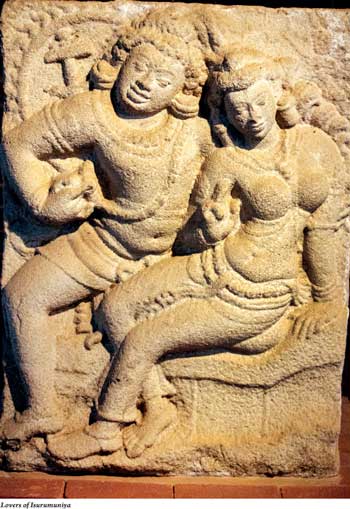Monday Dec 22, 2025
Monday Dec 22, 2025
Saturday, 13 January 2018 00:10 - - {{hitsCtrl.values.hits}}
 By Aysha Maryam Cassim
By Aysha Maryam Cassim
On the east side of Tisa Wewa embankment is a rock temple that is renowned for its antique sculptural embellishments. Isurumuniya Raja Maha Viharaya in Anuradhapura was built out of a group of huge granite boulders. The main temple is set around a lovely lotus pond, above which there is a black granite surface moulded with figures in bas-relief such as ‘The Water Elephants, and ‘The Man and the Horse’.
Ancient Issarasamana or Isiramana Vihara was founded by King Devanampiyatissa in the 3rd century BC. The word Isurumuniya is a Sinhalisation of the Sanskrit terms Ishwara and Muni. The temple may well have been a shrine sacred to God Siva, the Iswara Muni.
On an inscription of the earliest period discovered in the precincts of Isurumuniya, one can find the word “Bo-Upulvan” as a part of the name given by King Kasyapa I (437-491 A.D) to this shrine in the 5th century A.D. Therefore, A.D.T.E. Perera says, “We may surmise that these early inscriptions were evidence to prove that the shrine Isurumuniya was once dedicated in honour of the great divine concept of the Sinhalese Buddhists, namely the God Upulvan – Vedic deity.”
Isurumuniya has been extensively renovated on several occasions by Kings of Anuradhapura era.The temple was established as a monastery to house 500 young high-caste bhikkhus who were ordained during the reign of Devanampiyatissa. Eminent priests sojourned in the caves of Isurumuniya during the early centuries of Buddhism.
Today the temple is visited by thousands of pilgrims and tourists. The cave temple that leads to a small boulder-top dagoba has a mirador which offers a panoramic view of Anuradhapura.
The steps leading to the old shrine room are guarded by two intricately carved ‘Muragal’. The interior of the sanctum has a statue of Lord Buddha in a seating position and the modern stone temple houses a massive reclining Buddha statue and a Bo tree reputedly grown from one of the right original saplings of Sri Maha Bodhi.
Isurumuniya’s most celebrated carvings
The Bathing Elephants
The water in the moat reflects the carvings of bathing elephants. The frolicking animals are the intrinsic focus of Isurumuniya rock reliefs. They make a striking visual impression as you enter the temple premises.
According to D.T. Devendra, the Isurumuniya elephant carvings vary in its representation. The animals are sometimes presented frontally, sometimes from the side and in part or whole. It could be suggested that the work was done by two sculptors with varied techniques, at different times.
The Man and the Horse
Etched into the rock face above the pond is a man seated next to a horse. The man sits in ‘Maharàjaleelasana’ (pose of the Great King) posture. His left arm stretches vertically down where the hand is placed palm downwards on the base. His right arm is resting on his right leg bent at the knee. The abstracted figure exudes a powerful countenance. When you observe the upper body in detail, there appears to be a ‘Poona Noola’ (A sacred thread which was worn by ancient ascetic people) around his neck.
Many of the sculptures in Isurumuniya are not, in fact, religious in nature. The renowned carvings reflect non-Buddhist secular themes and symbols. The sculptural depictions are debatable.
For example, Parjanyi of Isurumuniya, the engraving of the horse and man has been a subject of controversy among scholars and historians. Ananda Kumaraswamy considered the sculpture to be an illustration of Kapila Muni of Indian Epic.
Former Archaeological Commissioner Professor Senarat Paranavitana inferred that the man was Parjanya or Varuna – the Rain God and the horse was Agni (fire.) From what we gather from Vedic literature, Parjanya represents water and it’s in water that Agni was believed to originate. According to Paranavitana’s interpretation, the seated figure of Parajanya and his tethered horse are harbingers of monsoon rains.
D.T. Devendra considered it to be the carving of the Greek hero Alexander and his favourite horse Bucephalus in 7th century AD.
The Lovers
“Isurumuniyehi pathali galaka hinda
Aalaya leelaya paa,
Vismitha galwaduwaaneni obahata
Apa naya gathi nowedo…”
The lyrics of the famous song sung by Chitra Somapala’s melodious voice revere Isuruminya’s sculptors who imparted their artistic ingenuity to the stone canvas. ‘The Lovers’ of Isurumuniya is a noteworthy piece of carving that attracts a lot of attention. You can find this work of art at The Archaeological Museum at Isurumuniya. The museum is also a repository for some of the most valued stone carvings that date back to the 5-6th century.
An amorous couple in a conspicuous ‘Sringara’ (erotic love) motif is thought to represent King Dutugemunu’s son Prince Saliya seducing his beloved Ashokamala, the ‘Chandala’ (untouchable caste) maiden whom he married. The tableau depicts a curvaceous woman etched gracefully on the right thigh of a seated man, her face turned away coyly from her partner.
The carvings indicate the influence of Gupta Art. The sophistication of Isurumuniya sculptures resembles with those remains at the early Pallava capital Mamallapuram in South India.
C.S. Navaratnam, in his essay ‘A Short Story of Hinduism in Ceylon,’ says that it appears to be a craving inspired by an Ajanta fresco. The sacred thread which is worn on the left shoulder of the male figure and the circular ‘Tiruvasi’ in the rear show the images to be Hindu deities.

